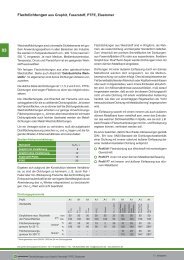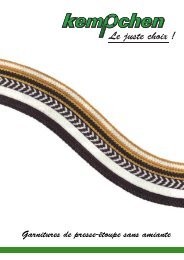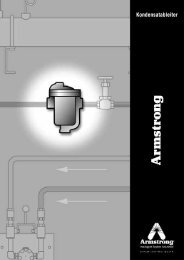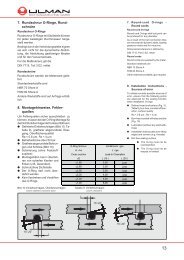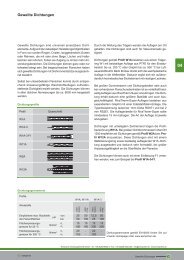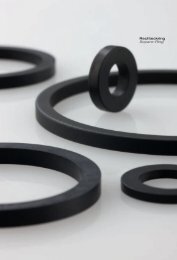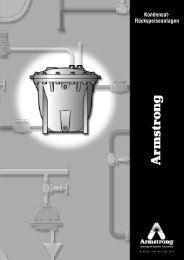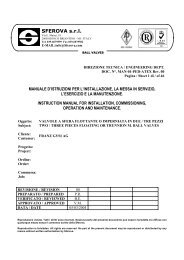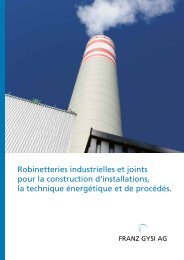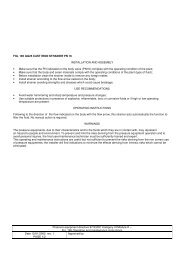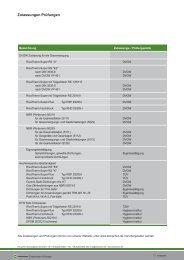Instructions for assembly and maintenance of the 451 / 851 Series ...
Instructions for assembly and maintenance of the 451 / 851 Series ...
Instructions for assembly and maintenance of the 451 / 851 Series ...
You also want an ePaper? Increase the reach of your titles
YUMPU automatically turns print PDFs into web optimized ePapers that Google loves.
<strong>Instructions</strong> <strong>for</strong> <strong>assembly</strong> <strong>and</strong><strong>maintenance</strong> <strong>of</strong> <strong>the</strong><strong>451</strong> / <strong>851</strong> <strong>Series</strong> safety valvesModelTÜV-Component Test<strong>451</strong> E, <strong>851</strong> E 268<strong>451</strong>P/N/T, <strong>851</strong>P/N/T 318<strong>851</strong> H1 541<strong>451</strong> H4, <strong>851</strong> H4 665<strong>451</strong> bG, <strong>851</strong> bG 666<strong>451</strong> bF, <strong>851</strong> bF 6841. Safety guidelines1. Only use <strong>the</strong> valve– <strong>for</strong> its intended purpose– if it is in proper operating condition– with respect <strong>for</strong> safety <strong>and</strong> potentialhazards.2. The installation instructions must be followedcarefully.3. Any defects which could affect <strong>the</strong> safeoperation <strong>of</strong> <strong>the</strong> valve must be rectifiedimmediately.4. The safety valve is only intended <strong>for</strong> use <strong>for</strong><strong>the</strong> range <strong>of</strong> applications listed in <strong>the</strong>seinstallation instructions. Any o<strong>the</strong>r use, oruse beyond that stipulated, is deemed to benot in accordance with <strong>the</strong> intendedpurpose.5. The manufacturer’s warranty shall be null<strong>and</strong> void if <strong>the</strong> sealed cover is removed.6. All <strong>assembly</strong> work must be carried out byauthorised specialists.
Inlet linesInlet lines <strong>for</strong> safety valves should be as short as possible<strong>and</strong> should be designed to ensure that no pressurelosses <strong>of</strong> more than 3 % <strong>of</strong> <strong>the</strong> set pressure can occurwhen <strong>the</strong> valve is operating under full load.Condensate trappingPipelines must be fitted with a continuously operatingdevice at <strong>the</strong>ir lowest point <strong>for</strong> condensate education thatmight build up. Care must be taken to remove any condensateor medium issuing from <strong>the</strong> system.The housing, lines <strong>and</strong> silencers must be protectedagainst freezing.Outlet lines / Back pressureThe outlet lines in <strong>the</strong> safety valve must be designed insuch a way that in <strong>the</strong> event <strong>of</strong> blowout <strong>the</strong> required massflow can be drawn <strong>of</strong>f without pressure.In <strong>the</strong> case <strong>of</strong> safety valves with bellows, a back pressure<strong>of</strong> up to 4 bar that occurs during blowout will notadversely affect <strong>the</strong> set pressure <strong>of</strong> <strong>the</strong> safety valve.5. Inspection / MarkingThe safety valves have been inspected by us, set to <strong>the</strong>required set pressure <strong>and</strong> lead-sealed.The set pressure is marked on <strong>the</strong> bonnet (spring cap) as<strong>the</strong> last figure <strong>of</strong> <strong>the</strong> component inspection code.Fig. <strong>451</strong> E, <strong>451</strong> P/N/T<strong>851</strong> E, <strong>851</strong> P/N/Twithout bellowsFig. <strong>451</strong> bF, <strong>451</strong> bG, <strong>451</strong> H4,<strong>851</strong> bF, 856 bG, <strong>851</strong> H1,<strong>851</strong> H4 with bellows6. Range <strong>of</strong> applicationsThe range <strong>of</strong> applications <strong>for</strong> <strong>the</strong> different models in<strong>the</strong> <strong>451</strong> / <strong>851</strong> <strong>Series</strong> can be found in <strong>the</strong> manufacturer’sspecifications (catalogue).
7. Operating / MaintenanceThe operating pressure in <strong>the</strong> system should be at least5 % less than <strong>the</strong> reseating pressure <strong>of</strong> <strong>the</strong> safety valve.This ensures that <strong>the</strong> safety valve can close again properlyafter a blowdown.If small leaks occur as a result <strong>of</strong> impurities lodgingbetween <strong>the</strong> sealing faces, <strong>the</strong> valve can be cleaned bygradually raising it until blowdown occurs.In addition, in <strong>the</strong> case <strong>of</strong> safety valves without bellows<strong>the</strong> entire top section can be unscrewed from <strong>the</strong> housingusing a suitable open-ended spanner (not a pipewrench) <strong>and</strong> any residue on <strong>the</strong> seat or seating sealremoved.Make sure that <strong>the</strong> safety valve is not pressurizedbe<strong>for</strong>e removing it.When <strong>the</strong> top section is screwed back into <strong>the</strong> housing,<strong>the</strong> operating pressure will remain unchanged.In <strong>the</strong> case <strong>of</strong> safety valves with bellows, <strong>the</strong> top sectionshould not be removed from <strong>the</strong> housing, as o<strong>the</strong>rwise aproper seal cannot be guaranteed if back pressureoccurs. The equipment can be cleaned by lifting up <strong>the</strong>safety valve. If this does not remedy <strong>the</strong> leak, <strong>the</strong> sealingface has probably been damaged. This can only berepaired in our factory or by an authorised specialist.Safety valves with bellows have a relief vent in <strong>the</strong> springcap. If medium discharges from this hole, it means that<strong>the</strong>re is a fault in <strong>the</strong> safety valve. In such cases, <strong>the</strong>safety valve must be overhauled.It is recommended, <strong>and</strong> is a requirement <strong>of</strong> <strong>the</strong> relevantregulations, that <strong>the</strong> correct operation <strong>of</strong> <strong>the</strong> safety valvein each system be regularly checked by lifting up <strong>the</strong>valve until it blows down.In accordance with TRD 601 regulations, safety valves insteam generators must be checked every 4 weeks toensure <strong>the</strong>ir correct operation.Safety valves are <strong>the</strong> last line <strong>of</strong> safety <strong>for</strong> a tank or system.They should be able to prevent excessive overpressureeven when all o<strong>the</strong>r upstream control <strong>and</strong> monitoringdevices have failed.Like every o<strong>the</strong>r piece <strong>of</strong> technical equipment, safetyvalves require regular servicing to ensure <strong>the</strong>ir operationalreadiness.ARMATURENFABRIK GERHARD GÖTZE KGRobert-Mayer-Strasse 21 · D-71636 Ludwigsburg
DECLARATION OF CONFORMITYaccording to Annex VII <strong>of</strong> Directive 97/23/ECWeArmaturenfabrik Gerhard Götze KG,D-71636 Ludwigsburgdeclare that <strong>the</strong> productSafety ValveTypeTÜV-TestCertificateEC-type examinationcertificate No.860 312 01 202 111-B- 00028<strong>451</strong>P/N/T, <strong>851</strong>P/N/T 318 01 202 111-B- 00028<strong>851</strong> H1 541 01 202 111-B-00029<strong>451</strong> H4, <strong>851</strong> H4 665 01 202 111-B-00029<strong>451</strong> bG, <strong>851</strong> bG 666 01 202 111-B-00029811 3 / 4“, 1“ 317 01 202 111-B-00026811 1 / 4“, 3 / 8“, 1 / 2“ 382 01 202 111-B-00026651 HN 516 01 202 111-B-00027<strong>451</strong> E, <strong>851</strong> E 268 04 202 1 460 03 00020<strong>451</strong> bF, <strong>851</strong> bF 684 04 202 1 460 03 00020652, 652 GL 293 01 202 2 046 01 60021to which this declaration is reffering to, is in compliancewith <strong>the</strong> directive 97/23/EC as well as <strong>the</strong> national specificationsAD 2000-A2/A4, TRD 421/721 <strong>and</strong> was subjectedto <strong>the</strong> following con<strong>for</strong>mity assessment procedure:Modul B+DThere is a EC-type examination certificate <strong>for</strong> <strong>the</strong> pressureequipment.The monitoring is per<strong>for</strong>med by TÜV-Süddeutschl<strong>and</strong> (CE0036)Ludwigsburg, 10. 08. 2003(Ort und Datum der Ausstellung)D. Weimann



